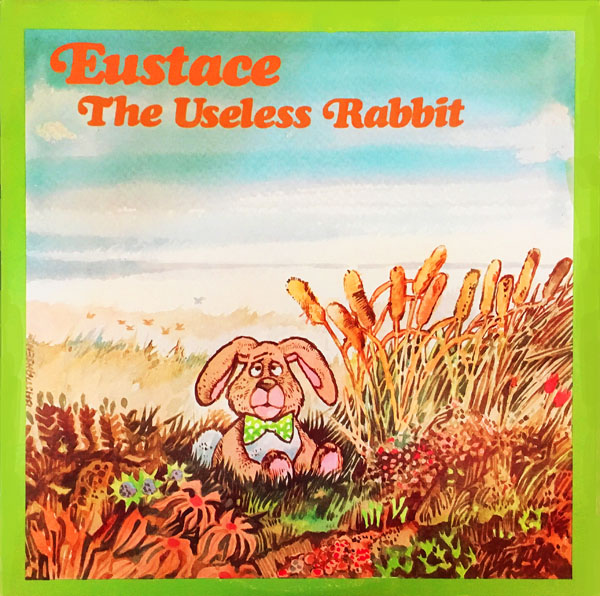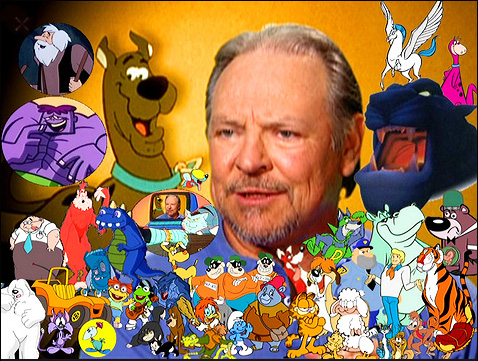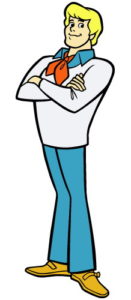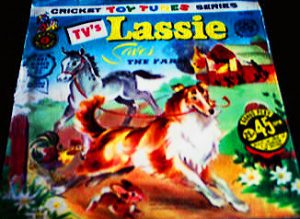Easter may have been last Sunday, but Frank Welker’s vast voice work is never done–so let’s hop over to a little-known Welker work in which he plays a beleaguered bunny.

EUSTACE, THE USELESS RABBIT and Other Stories
Pickwick Records SPC-5168 (12” 33 1/3 RPM LP / Enhanced Mono for Stereo)
Released in 1981. Producer: Stan Zabka. Engineer: Jon Wolff. Cover Art: Peter Bastiensen. Art Direction: Yves Roux. Special Thanks: Norm Prescott, Wayne Novak, Johnny Oliver. Running Time: 31 minutes.
“Eustace” Voices: Frank Welker (Eustace, Freddy Fox, Billy Beaver, Eustace’s Mom, Chirpy, Guy Goose, Danny Duck, Gavin Groundhog, Ryan Roadrunner); Glenn Ash (Soloist, The Artist).
Song: “Eustace, the Useless Rabbit” by Jane Paulette Steinkamp, Stan Zabka.
Performers (Other Stories): Paul DeWitt, Betty Shepard, Rose Marie Jun, The Cricketones, The Cordials, Warren Vincent Orchestra.
Other Stories: “Bumpy and the Bingtown Band,” “Lassie Saves the Farm,” “Tutu, the Little Ballerina” (all from 1956).
Other Song: “Hi Lili, Hi Lo” (from Lili) by Bronislau Kaper, Helen Deutsch (1956).
It is unlikely that anyone would dispute Frank Welker’s position as dean of today’s voice actors, in the league of Paul Frees and June Foray. Among his classic voices are Freddy Jones and Scooby-Doo, Garfield, Curious George—and even Oswald the Lucky Rabbit.
In Hollywood terms, if one were to tally the box office of films in which he performs (Aladdin, Transformers, Tangled, Toy Story 3, and Tim Burton’s Alice in Wonderland, to name a few), Frank Welker ranks as the number three highest grossing actor in the motion picture industry with 110 films and a total $15,953,527,531 in worldwide aggregate box office.

He began on stage and on screen doing uncanny impressions, with small roles in such films as Disney’s 1971 Kurt Russell comedy hit Now You See Him, Now You Don’t (look for him at 50:00 in a scene with Mike Evans, later of The Jeffersons, and Jack Bender, who appeared on All in the Family that year as a hippie). Welker also made the talk show circuit until Scooby-Doo ignited his 40-year voice acting career. In 2016, he received a Lifetime Achievement Emmy Award.
 Said Mark Evanier on his must-read blog, newsfromme.com: “Frank is the “workingest” animation voice guy in history, meaning that he’s hired and heard more than anyone else who does that kind of work. He is also so versatile that other folks who do that are in awe of his skills and also of the man himself. I’ve heard more than a few of his fellow voice actors express their amazement that a person who has been in such demand for that long isn’t the least bit arrogant or unprofessional.”
Said Mark Evanier on his must-read blog, newsfromme.com: “Frank is the “workingest” animation voice guy in history, meaning that he’s hired and heard more than anyone else who does that kind of work. He is also so versatile that other folks who do that are in awe of his skills and also of the man himself. I’ve heard more than a few of his fellow voice actors express their amazement that a person who has been in such demand for that long isn’t the least bit arrogant or unprofessional.”
Besides various film soundtracks in which he basically appears through his vocal effects, and Peter Pan’s Scooby-Doo records (see this Spin), there are not a lot of Frank Welker records. Eustace the Useless Rabbit is a rare exception. Quietly released in 1981 by Pickwick Records back when they operated several retail record store chains (Musicland, Sam Goody, etc.), the story may very well have been recorded independently and acquired by Pickwick, as its sound and style bears no resemblance to any of its recordings of the era.
“Eustace the Useless Rabbit” had appeared on Golden Records twice in 1954 as a novelty holiday tune along the lines of “Rudolph, the Red-Nosed Reindeer,” in which a little fellow has trouble fitting until he triumphs in the end. The song was reissued several times, including the vinyl LP Peter Cottontail and Other Easter and Springtime Favorites. It is not on CD, but Verse Music included it on their Golden Easter compilation album, which is available for download.
It lists Roy Rogers and Dale Evans as the singers, but it is actually Mike Stewart with the Sandpipers with Jimmy Carroll’s Orchestra directed by Mitch Miller:
The co-writer and producer of “Eustace” is songwriter Stan Zabka, whose other hits include “Christmas Eve in My Hometown” and the original Tonight Show theme, “Chimes.” The other writer is Jane Paulette Steinkamp of The Paulette Sisters. The trio recorded for several major labels including Decca, Capitol and Columbia, for which they recorded “Following the Leader” from Disney’s Peter Pan.
As it is heard on the Pickwick album, the Eustace story goes into a little more detail and creates additional characters, most of them designed for taunting á la Rudolph. Billy Beaver is his closest friend, but even he wearies of Eustace’s lackadaisical, whiney manner. When “The Artist” comes along to costume Eustace as the Easter Bunny, the idea seems to be that this would be the first time anyone was a living personification of the holiday figure.
In this sense, The Artist is the equivalent of Haddon Sundblom, the illustrator known for his Santa Claus Coca-Cola ads. The Artist is played by character actor and folk singer Glenn Ash (sometimes spelled with one ‘n’), who made scattered appearances on network TV series of the baby boom era like Mayberry RFD, Gomer Pyle, USMC, M*A*S*H and Rowan and Martin’s Laugh-In, usually as big, affable fellows. Here’s an episode of Petticoat Junction titled after the character he plays:
Side two of the Pickwick Eustace album is a grab bag of vintage Cricket records (Pickwick’s first childen’s label), all from 1956. Chief among them is Lassie Saves the Farm, a studio cast recording that mentions Jeff, connecting it to the Tommy Rettig / Jan Clayton version of the show.
 It’s a good example of the Warren Vincent Cricket records of the day, filled with short tunes that advance the story and little gags like Gramps scolding the chorus for calling him “old.” Bumpy and the Bigtown Band gives us Paul DeWitt doing his Jimmy Stewart impression (he also appeared on Cricket’s Gerald McBoing-Boing records in this Spin).
It’s a good example of the Warren Vincent Cricket records of the day, filled with short tunes that advance the story and little gags like Gramps scolding the chorus for calling him “old.” Bumpy and the Bigtown Band gives us Paul DeWitt doing his Jimmy Stewart impression (he also appeared on Cricket’s Gerald McBoing-Boing records in this Spin).
De Witt is also on hand for the beautiful “Hi-Lili, Hi-Lo,” a very popular song of 1956, in a duet with the great New York demo and studio vocalist Rose Marie Jun, who sang for Jane Jetson on Golden’s musical LP of The Jetsons, (see this Spin). And then there’s Tu Tu, the Little Ballerina, a yarn that seems to suggest to little girls of the ’50s that practicing ballet will lead to an improbable star turn followed by marriage to royal hunks. (Little Girl: “Mommy, I don’t want to go to dancing school.” Mother: “But darling, you MUST.”)
“Eustace, the Useless Rabbit”
Not only does Frank Welker perform nine characters in this story, but he plays the crowd scenes. Note the scenes in which his dialogue is layered over his own background chatter.


 GREG EHRBAR is a freelance writer/producer for television, advertising, books, theme parks and stage. Greg has worked on content for such studios as Disney, Warner and Universal, with some of Hollywood’s biggest stars. His numerous books include Mouse Tracks: The Story of Walt Disney Records (with Tim Hollis). Visit
GREG EHRBAR is a freelance writer/producer for television, advertising, books, theme parks and stage. Greg has worked on content for such studios as Disney, Warner and Universal, with some of Hollywood’s biggest stars. His numerous books include Mouse Tracks: The Story of Walt Disney Records (with Tim Hollis). Visit 






















































The oldest available color footage from The Tonight Show is of Stan Zabka frim 1964, performing with the show’s band (when Skitch Henderson was still conductor). No cartoon music here, but there’s some playfulness starting about the 3:25 mark in the video — https://www.youtube.com/watch?v=pq-e-DNZp2k
The movie in which Welker got the most face time is perhaps the Don Knotts vehicle “How to Frame a Figg.”